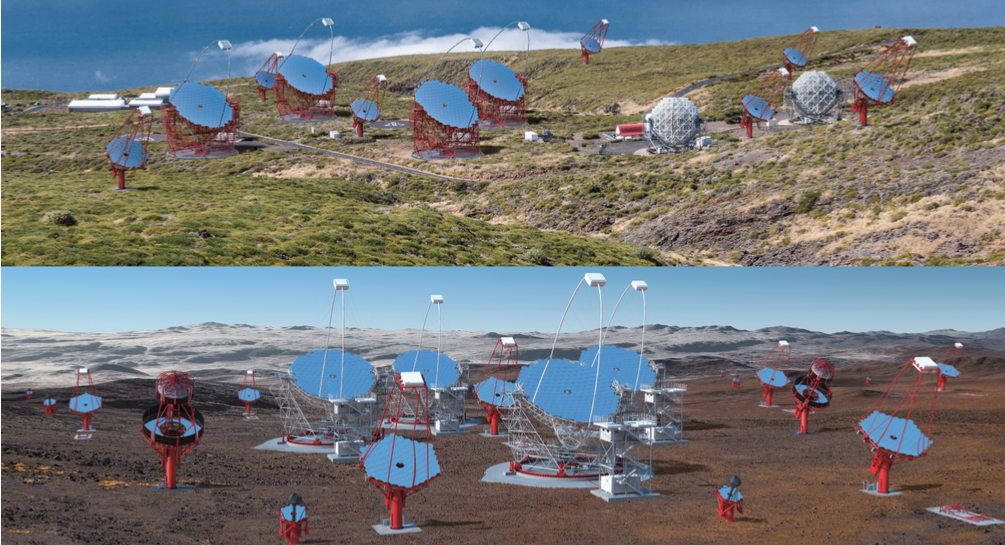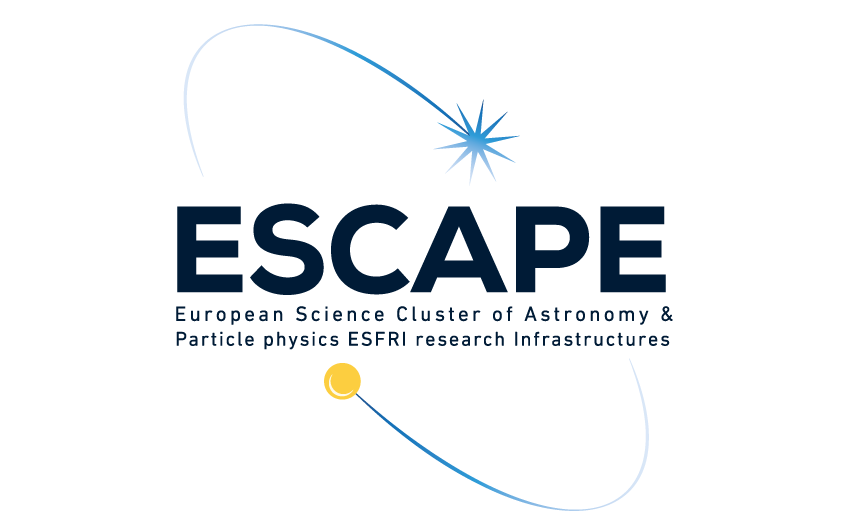
Astrophysics
Cherenkov Telescope Array Observatory
The CTA Headquarters (HQ): Heidelberg (Germany); Local Office: Bologna (Italy); the CTA Science Data Management Centre (SDMC): Zeuthen (Germany); Two telescope array sites: CTA-North at the Roque de los Muchachos Observatory on the island of La Palma
Contacts:
www.cta-observatory.org
The Cherenkov Telescope Array Observatory (CTAO) will be the first ground-based gamma-ray observatory and the world’s largest and most sensitive instrument for the gamma-ray astronomy at very-high energies. It will be the first of its kind open to the world-wide astronomy and physics communities, providing a unique resource of data products and tools. The project started in 2005, when scientists around the world proposed the first design concept for a next-generation gamma-ray facility, and we currently estimate the Observatory to be completed around 2028.
The Observatory will have two telescope array sites: The CTAO Northern Array, at the Instituto de Astrofísica de Canarias’ (IAC’s) the Roque de los Muchachos Observatory on the island of La Palma (Spain), and the CTAO Southern Array, near the European Southern Observatory’s (ESO’s) Paranal Observatory in the Atacama Desert (Chile). CTAO’s three classes of telescope will cover a broad, unprecedented energy range from 20 GeV to 300 TeV: the Large-Sized Telescope (LST), the Medium-Sized Telescope (MST) and the Small-Sized Telescope (SST). During the Construction Phase, the plan for CTAO Northern Array includes 4 LSTs and 9 MSTs, whilst the CTAO Southern Array will feature 14 MSTs and 37 SSTs.
The preparation of the design and implementation of the Observatory is managed by the CTAO gGmbH, which is governed by shareholders and associate members from a growing number of countries. The CTAO gGmbH is the interim legal entity until the final legal entity, a European Research Infrastructure Consortium (CTAO ERIC), is achieved. The CTAO gGmbH works in close cooperation with the Cherenkov Telescope Array Consortium (CTAC), composed of more than 1,500 members from 25 countries, which is contributing to the definition of the instrument design and the scientific programme. The CTAO Headquarters is in Bologna (Italy), collocated with the Department of Physics and Astronomy of the University of Bologna at the National Institute for Astrophysics (INAF) campus. The building for the CTAO Science Data Management Centre (SDMC), in charge of coordinating the processing and preservation of data, as well as to provide tools and support to scientific users, is currently under construction at the DESY campus in Zeuthen (Germany).

“CTA Science: Emission to Discovery.” Credit: CTAO GmbH
CTAO Scientific Challenges
Ground-based gamma-ray astronomy is a young field with enormous scientific potential. The current instruments H.E.S.S., MAGIC and VERITAS have been operated since 2003 and have already demonstrated the huge scientific potential of astrophysical measurements at TeV energies. CTAO, built on the same technology, expects expanding the number of known cosmic sources by as much as 5- to 10-fold, potentially detecting 1,000 new objects.
With its superior performance, CTAO will significantly increase the potential for discovery, paving the way to new questions and, likely, paradigm-changing breakthroughs. In particular, CTAO has an unprecedented sensitivity to short (sub-minute) timescale phenomena, which places it as a key instrument in the future multi-messenger and multi-wavelength time domain astronomy. Transient phenomena are of great scientific interest, being associated with catastrophic events involving relativistic compact objects, such as neutron stars and black holes. The proposed targets comprise gamma-ray bursts, gravitational wave alerts, neutrino alerts, optical/radio transient events and serendipitous very-high-energy discoveries.
The main scientific challenges of CTAO are related to expand the understanding of known objects and astrophysical mechanisms and even unveil new physics, gathered in three major study themes:
1. Understanding the origin and role of relativistic cosmic particles
Relativistic particles seem to play a key role in great part of celestial objects, but the mechanisms for, and the sites of, cosmic acceleration are not yet fully understood nor are their impact on star-formation process and the evolution of galaxies. With its high angular resolution and large field of view, that allows fast surveys of the gamma-ray sky, CTAO will be able to disentangle nearby sources providing accurate measurements on known and new sources and even proffer a census of particle accelerators in the Universe.
2. Probing extreme environments
The most energetic electromagnetic radiation and highest-energy particles are usually associated to the most extreme environments in the Universe, such as those nearby neutron stars and black holes. From their vicinities, relativistic jets (beams of matter moving almost at the speed of light), violent winds and explosions arise, where gamma rays originate. Gamma-ray emission can therefore act as a probe of these surroundings and help to understand the emission and acceleration processes that govern there.
3. Exploring frontiers in physics
Dark matter is thought to account for a large part of the total mass of the Universe and still, its nature remains to be one of the greatest mysteries in science. The improved energy resolution will increase CTAO’s ability to look for features in the spectrum of gamma rays produced when dark matter particles (believed to be Weakly Interacting Massive Particles, or WIMPs) annihilate one another when they interact. Moreover, CTAO may also provide evidence of deviations from the Einstein’s theory of special relativity, as well as the existence of axion-like particles and answers to the contents of cosmic voids.
Some of the most promising discoveries and interesting sources to address these key science themes will come from our own Galaxy, the Milky Way, which holds remnants of supernova explosions (SNRs) and pulsar wind nebulae (PWNe), binary systems hosting a neutron star or a black hole, and rapidly spinning, magnetized and ultra-dense stars known as pulsars. Beyond the Milky Way, CTAO will search for star-forming galaxies, galaxies with supermassive black holes in their centres (called Active Galactic Nuclei) and even galaxy clusters.
ESCAPE Impact to CTAO
ESCAPE provides an excellent framework to test technologies, workflows and use cases in the real world which is invaluable for a future international open observatory such as the CTAO. It also presents the perfect opportunity to collaborate with other ESFRIs. Briefly, it is an ecosystem of services working in unison and therefore a unique opportunity to perform a joined-up analysis which follows best practices. This is facilitated by easy access to data from multiple sources and the ability to run an analysis or data management tasks.
CTAO is interested in providing easy access to the CTAO data products for scientists worldwide, and high-quality science software to analyse the data. Multimessenger and multiwavelength physics is one of its cornerstones, which requires interoperable data and common access across different wavelengths, experiments and observatories. CTAO also supports open science and FAIR (Findability, Accessibility, Interoperability, and Reusability) principles, which will enhance the CTAO software and data products.
As an open observatory, the CTAO has the responsibility to provide high-quality data as a service to the community and work closely with other observatories. CTAO was therefore acutely interested in contributing to the construction of a common ESCAPE platform (EOSC cell).
As CTAO is heading to the Construction and Operation Phases, which will begin with the establishment of its final legal entity as a European Research Infrastructure Consortium (CTAO ERIC), its main achievements within ESCAPE can be divided in:
- - Build collaborations with other observatories to gain experience and insight;
- - Testing and prototyping solutions with ESCAPE technologies;
- - Creating a link between the ESCAPE project and CTAO construction activities.
ESCAPE DIOS, ESCAPE OSSR and ESCAPE VO

ESCAPE has helped CTAO establish the foundations of experience and knowledge in key aspects such as, data lake technologies (from ESCAPE DIOS), software repositories and policies (from ESCAPE OSSR), as well as the understanding for the construction of a science platform (from ESCAPE DIOS) and the development of links to the Virtual Observatory (from ESCAPE VO).
CTAO has also been able to test several of its use cases on ESCAPE systems, whilst also implementing example analysis workflows. ESCAPE has also brought CTAO into close contact with other ESFRIs infrastructures leading to joint projects on many topics.
Multimedia
- Videos: https://www.youtube.com/c/CherenkovTelescopeArrayObservatory
- Images: https://www.flickr.com/photos/cta_observatory/
- Materials: https://www.cta-observatory.org/outreach-education/multimedia/print-materials/
LEARN MORE ABOUT HOW ESCAPE IS SUPPORTING THE OTHER RESEARCH INFRASTRUCTURES


